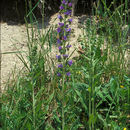mk
имиња во трошки


Echium vulgare, known as viper's bugloss and blueweed,[1] is a species of flowering plant in the borage family Boraginaceae. It is native to most of Europe and western and central Asia[2][3] and it occurs as an introduced species in north-eastern North America, south-western South America and the South and North Island of New Zealand.[1][4] The plant root was used in ancient times as a treatment for snake or viper bites.[5] If eaten, the plant is toxic to horses and cattle through the accumulation of pyrrolizidine alkaloids in the liver.[6][7]
It is a biennial or monocarpic perennial plant growing to 30–80 cm (12–31 in) tall, with rough, hairy, oblanceolate leaves.[8] The flowers start pink and turn vivid blue, and are 15–20 mm (0.59–0.79 in) in a branched spike, with all the stamens protruding. The pollen is blue[9] but the filaments of the stamens remain red, contrasting against the blue flowers. It flowers between May and September in the Northern Hemisphere. The Latin specific epithet vulgare means common.[5]
It is native to Europe and temperate Asia. It has been introduced to Chile,[10] New Zealand[11] and North America, where it is naturalised in parts of the continent including northern Michigan,[3] being listed as an invasive species in Washington.[12] It is found in dry, calcareous grassland and heaths, bare and waste places, along railways and roadsides and on coastal cliffs, sand dunes and shingle.[13]
E. vulgare is cultivated as an ornamental plant, and numerous cultivars have been developed. The cultivar 'Blue Bedder' has gained the Royal Horticultural Society’s Award of Garden Merit.[14][15]
Being pollinated by skipper butterflies
Echium vulgare, known as viper's bugloss and blueweed, is a species of flowering plant in the borage family Boraginaceae. It is native to most of Europe and western and central Asia and it occurs as an introduced species in north-eastern North America, south-western South America and the South and North Island of New Zealand. The plant root was used in ancient times as a treatment for snake or viper bites. If eaten, the plant is toxic to horses and cattle through the accumulation of pyrrolizidine alkaloids in the liver.